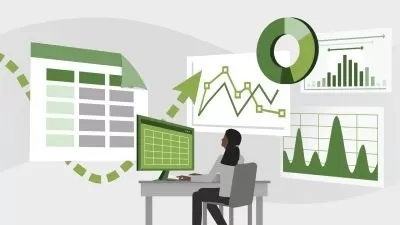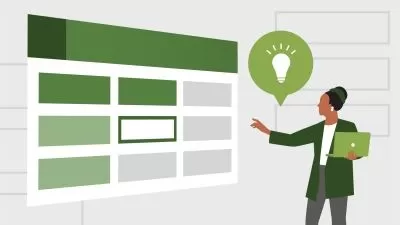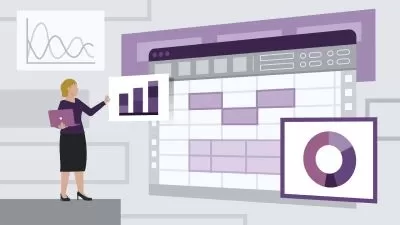Tableau Crash Course with Real Projects & Hands On Learning
Graeme Gordon
4:46:56
Description
Create and Design THREE of your own automated dashboards - two stock performance and one cryptocurrency
What You'll Learn?
- Create our own Stock and Cryptocurrency Price Trackers and Portfolio Performance Dashboards
- Learn how Tableau is used to create an automated live dashboard which is published online
- Understand best practices when visualizing data
- Import live data from Google Sheets and set it up to refresh automatically
Who is this for?
What You Need to Know?
More details
DescriptionWelcome to the world of data visualization with Tableau! In this hands-on course, you will learn how to create your own interactive and dynamic stock and cryptocurrency dashboards using Tableau, a leading data visualization tool.
If you are interested in becoming a data analyst, or working with Tableau to visualize data, this course is a great place to understand everything from connecting to your dataset to finishing and publishing your visual dashboard.
Starting with the basics, you will learn how to connect to various data sources, import and clean data, and create visualizations using Tableau's drag-and-drop interface. You will then dive into advanced techniques such as creating calculated fields, using parameters, and creating interactive filters to dynamically monitor stock and cryptocurrency data.
We will cover:
Data Visualization using Tableau public - We will create a Donut Chart, Line Chart, Area Charts, Lollipop Chart, Bubble Chart and many more.
Calculated Fields - Create a new field using the data you have by creating a calculation.
Parameters - Workbook variables we will create to allow us to filter the data based on specified conditions.
Connect to Data Source - Connecting to Google Sheets as our data source and setting them up to automatically refresh using Google Apps Script.
Conditional Statement - We'll create conditional statements using the IF/ELSE function.
Tiled and Floating Dashboard Design - We will create both tiled and floating dashboards so you can see the difference.
Sets - Use a set to create top 3 stocks by holdings.
Tooltips - Display extra information when user hovers over a element.
Upload custom icons and insert navigation links - We will use the icons as filters.
Trend Lines - Make it easier to spot trends in our line charts
and much more!
Join now and unlock the power of Tableau to create dynamic and visually stunning stock and cryptocurrency dashboards that will elevate your data-driven decision making to the next level! Enroll in this course today and embark on your journey to becoming a data visualization pro with Tableau.
Please note: For these Dashboards I am not advising you to buy any of the stocks shown in it. It is for educational purposes only.
Who this course is for:
- Anyone who wants to learn Tableau from scratch and create live automated dashboards which can be used to see your own Stock and/or Cryptocurrency portfolio
- Anyone interested in becoming a data analyst.
Welcome to the world of data visualization with Tableau! In this hands-on course, you will learn how to create your own interactive and dynamic stock and cryptocurrency dashboards using Tableau, a leading data visualization tool.
If you are interested in becoming a data analyst, or working with Tableau to visualize data, this course is a great place to understand everything from connecting to your dataset to finishing and publishing your visual dashboard.
Starting with the basics, you will learn how to connect to various data sources, import and clean data, and create visualizations using Tableau's drag-and-drop interface. You will then dive into advanced techniques such as creating calculated fields, using parameters, and creating interactive filters to dynamically monitor stock and cryptocurrency data.
We will cover:
Data Visualization using Tableau public - We will create a Donut Chart, Line Chart, Area Charts, Lollipop Chart, Bubble Chart and many more.
Calculated Fields - Create a new field using the data you have by creating a calculation.
Parameters - Workbook variables we will create to allow us to filter the data based on specified conditions.
Connect to Data Source - Connecting to Google Sheets as our data source and setting them up to automatically refresh using Google Apps Script.
Conditional Statement - We'll create conditional statements using the IF/ELSE function.
Tiled and Floating Dashboard Design - We will create both tiled and floating dashboards so you can see the difference.
Sets - Use a set to create top 3 stocks by holdings.
Tooltips - Display extra information when user hovers over a element.
Upload custom icons and insert navigation links - We will use the icons as filters.
Trend Lines - Make it easier to spot trends in our line charts
and much more!
Join now and unlock the power of Tableau to create dynamic and visually stunning stock and cryptocurrency dashboards that will elevate your data-driven decision making to the next level! Enroll in this course today and embark on your journey to becoming a data visualization pro with Tableau.
Please note: For these Dashboards I am not advising you to buy any of the stocks shown in it. It is for educational purposes only.
Who this course is for:
- Anyone who wants to learn Tableau from scratch and create live automated dashboards which can be used to see your own Stock and/or Cryptocurrency portfolio
- Anyone interested in becoming a data analyst.
User Reviews
Rating
Graeme Gordon
Instructor's Courses
Udemy
View courses Udemy- language english
- Training sessions 39
- duration 4:46:56
- Release Date 2023/06/12














